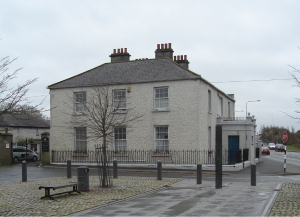Revolution in Maynooth
March 1920 – July 1921
Published in the Liffey Champion, 23rd of January 2021
One hundred years ago during the high point of the War of Independence, revolution was experienced in Maynooth in a more general way than in any other town or village in County Kildare. In addition, Maynooth was the only town in Kildare to experience militancy during all three periods of major conflict throughout the revolution; a connection with Easter Week 1916, the War of Independence (1919–21) and the Civil War (1922–23).
Vacated RIC Barracks…
…Burned
The War of Independence began in 1919 with a militant campaign directed against the Royal Irish Constabulary [RIC]. While this militancy did not affect Kildare directly, attacks on RIC barracks close to the county at Athboy in Meath and Baltinglass in Wicklow resulted in the closure of smaller barracks. In late 1919 outlying barracks in North Kildare at Donadea and Ballinadrimna were closed. Early in the following year the closure of barracks accelerated, beginning with Leixlip in the first week in March, followed by Kilcock and Maynooth in the following week. Celbridge barracks which was located in the well-fortified Mill complex remained open and was strengthened by RIC officers from the various vacated barracks. By the summer of 1920, it was the only RIC barracks remaining open in North Kildare. The RIC soon realised that evacuating too many barracks in Kildare, a largely peaceful county, was a mistake and pressure mounted for some of the barracks to be re-opened. In late March 1920 rumours circulating in Maynooth, suggesting that the local barracks was to be re-opened. Immediate action was taken and on the night of 22–23 March 1920, the local IRA torched the barracks which is the building where Maynooth Garda Station is now situated. It was a well-planned operation with great care taken for the safety of the wife of Sergeant Moore who resided in the building with accommodation provided for her in a nearby premises.
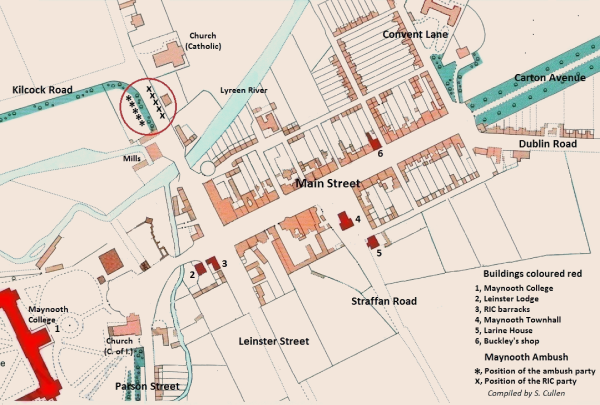
Map of Maynooth.
The IRA headquarters in Dublin now authorised the destruction of all vacated barracks to be carried out at Easter 1920. Patrick Colgan, officer commanding the North Kildare IRA Battalion was in charge of the operation throughout northern Kildare. Donadea barracks was burned on Friday night the 3rd of April, while the following night it was the turn of Clane Barracks. With Kilcock barracks already burned, Leixlip presented a problem for Colgan. The sergeant and his family resided in the building which was situated in the centre of the village only one and a half miles from Lucan RIC barracks where a large force of RIC were stationed. On the 10th of April, in a well-planned operation the IRA stormed the building, Sergeant Lane surrendered and together with his wife and family were escorted from the scene. Some family members were allowed to salvage belongings before the building was torched.
Maynooth Townhall…
…Bombed
Throughout the late Spring rumours persisted in Maynooth that Crown forces were planning to re-establish a barrack in Maynooth and speculation focused on the townhall situated in the middle of the Square in the town. The IRA now put in place plans to destroy the building. On the 14th May, Stephen O’Reilly from the Dublin Brigade carried out the operation, with 30 lbs of gelignite. He was assisted by the local IRA including Patrick Colgan. O’Reilly was in no hurry to leave Maynooth and retired to Buckley’s house where he enjoyed a leisurely meal before cycling back to Dublin. With no British security presence in the area, Michael Collins was able to travel to Maynooth, to inspect the damage.
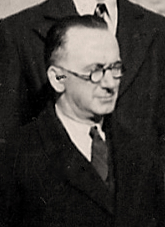
Patrick Colgan.
The extent to which the IRA controlled North Kildare at this time was clearly visible. ‘Volunteer police patrols’ were active nightly in Maynooth and Kilcock enforcing an order issued by Dáil Éireann, providing that public-houses only supply drink from 7am until 10.30am. Republican Courts presided over by key IRA activists which included Donal Buckley had replaced the Crown Courts. Republican control of the area was further boosted by the evacuation on the 30th of August of Celbridge Barracks with the RIC redeployed to Lucan. Within hours the IRA burned the vacant barracks and adjoining courthouse.
From the point of view of the Dublin Castle authorities it was an intolerable situation having no police presence in North Kildare and particularly in Maynooth where the leading Catholic College in the country was sited. Maynooth at the time was regarded by many as having a form of capital status due to the college being the regular meeting place of the Irish Catholic Bishops.
Leinster Lodge…
…Burned
By December 1920 rumours again began to circulate in Maynooth regarding attempts to establish a police barracks with speculation on this occasion centred on a house known as Leinster Lodge. It was situated between the burnt-out barrack and the entrance to the College and was owned by relatives of Donal Buckley, who had leased it to a veterinary surgeon James Wade. On the night of the 2–3 January 1921, at fifteen minutes past midnight the IRA commandeered the premise. A New Year’s party was taking place in the house and the occupants were locked in one room while men removed the furniture and a car from the adjoining garage. The occupants were then ordered to leave. The Wade family were accommodated by neighbours and the house was torched. The raid was well-planned, telephone wires were cut beforehand, and it is known that at least forty men participated. The building was completely gutted with only the walls left standing. The cost of the damage was considerable, with the freeholders of the property claiming £4,000 compensation from the ratepayers.
In early 1921, part of the main street in Maynooth to some extent resembled a street in Dublin following the Easter Rising. The Courthouse in the centre of the town was a burnt-out shell and two buildings side by side close to the college entrance, the former police barracks and Leinster Lodge were also in a ruinous state as a result of revolution.
Larine House
New Black & Tan Barrack
The rumours regarding Dublin Castle’s determination to establish a police barracks in Maynooth were accurate. In mid-January Larine House, in the centre of the town was acquired and a police contingent consisting of regular RIC and Black and Tans were stationed in the building. It had been the local dispensary and the boyhood home of Ted O’Kelly who had organised the Kildare Volunteers in 1916. The house with adjoining courtyard became the Black and Tan headquarters for North Kildare.
Almost immediately the Black and Tans made their presence felt. One of their first activities involved an incident in Donal Buckley’s shop. On the 27th of January, while the shop was closed, a party of Tans smashed in the door and threatened Liam O’Regan the foreman of the shop. He was ordered to remove the Irish name of the proprietor from the entrance step of the door and informed that the building would be blown up if he refused. The raiders took a pot of red paint from the premises and painted the initials B and T [Black and Tans] on the front of the shop and also the words ‘God save the King’. While this was taking place one of Donal Buckley’s daughters ran across the road to the barrack at Larine House and got the RIC sergeant to intervene which defused the situation.
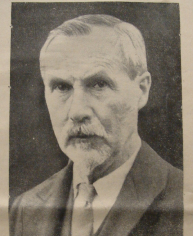
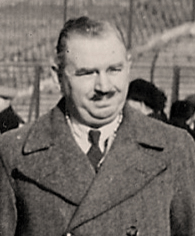
Donal Buckley & Liam O’Regan.
Houses in the town were now regularly searched which included the residence of the Kenny family who lived close to Buckley’s shop. Arms at this time were hidden in the house and Ellen Kenny smuggled the guns under her coat walking from the house to Maynooth College where they were hidden by her brother John who worked in the office of the president of the college.
Maynooth Ambush
21th February 1921
While these events were taking place the local IRA planned an assault on the police patrols that had re-commenced in the town. The ambush was organised by Paddy Mullaney who had been appointed in charge of the local IRA Battalion following Colgan’s arrest. On the night of the 21st of February, two IRA parties took up positions, one close to Kavanagh’s Mills now the Mill Shopping Centre, manned by Kilcock men led by Mick Flynn and a second party with Mullaney himself in charge positioning themselves on the Leixlip side of the town. While the IRA were unsure which direction the police patrol would take, two of the expected routes were covered. The patrol consisting of one RIC Sergeant and five constables walking in single file headed in the direction of the Kilcock road and as they were passing Kavanagh’s Mill, the IRA concealed behind a wall opened fire. Sergeant Hughes, thirty-four years old and a native of Wolfhill County Laois died in the exchanges before the attackers withdrew.
Following the ambush, fears of retaliation in Maynooth by the Black and Tans led to an almost complete evacuation of the civilian population from the town. However, unlike the aftermath of ambushes at Kill and Balbriggan where reprisals occurred, no harm was inflicted. The fact that the Catholic College was situated in the town may have saved Maynooth from retaliation as the Castle authorities would have been fearful of negative publicity. Nevertheless, a curfew was subsequently imposed from 9pm to 5am and also certain restrictions which prohibited any fairs or markets being held within a two-mile radius of the new barracks in Maynooth.
The police in the town were now under pressure and the likelihood of further attacks by the IRA had a detrimental mental effect. Two weeks after the ambush, on the 7th of March, Constable Harold Stiff a Black and Tan from Canning Town, London, died from self-inflicted wounds in a room in the barrack. Stiff was due to take part in patrol duty and the pressure of dangerous police work and targeting by the IRA may have been a contributing factor to the suicide.
Despite the truce coming into effect on the 11th of July 1921, the Black and Tan presence continued in Maynooth. While the IRA continued to operate in a non-militant activity, police patrols continued in the town with liaison officers appointed to supervise the truce. Following the Treaty, the disengagement of Crown forces began. On the morning of Friday the 24th of March 1922, the remaining RIC and Black and Tans in Maynooth vacated the barracks which was then handed over to Provisional Government representatives Captain McKenna and the liaison officer Sean Kavanagh. In Maynooth this phase of the conflict had now ended.
Sources
- Patrick Colgan (Irish Military Archives [IMA], BMH WS 850).
- Stephen O’Reilly (IMA, BMH WS 1,761).
- Compensation Ireland commission Kildare, 1919–1922 (National Archives London [TNA], CO 905/7).
- RIC reports, CI Kildare, Feb. 1921 (TNA, CO 904/114).
- Paddy Mullaney interview (UCD Archives, O’Malley notebooks, P17b/106,110).
- Hugh Jeudwine, ‘History of the 5th Division in Ireland, November 1919 – March 1922’, (Imperial War Museum (IWM) London, Jeudwine papers, 72/82/2).
- Inquest on the death of Harold Stiff, 7 Mar. 1921 (TNA, WO/159B/14).
- Properties handed over to the Provisional government by 18 May 1922 (IMA, Liaison and evacuation papers, LE/14/2).
- Kildare Observer, 27 March, 10 April, 24 July 1920.
- Leinster Leader, 3 & 10 April 1920, 27 January, 12 March 1921.
- Freemans Journal, 28 January, 1921.
- Seamus Cullen, Kildare: the Irish Revolution, 1912–23 (Dublin, 2020).
- John Drennan, Cannon balls and Croziers (Maynooth, 1994).
- Adhamhnán Ó Súilleabháin, Domhnall Ua Buachalla: Rebellious Nationalist, Reclusive Governor (Dublin, 2015).
- Interviewees: Ena Dooley; Tony Maher.

